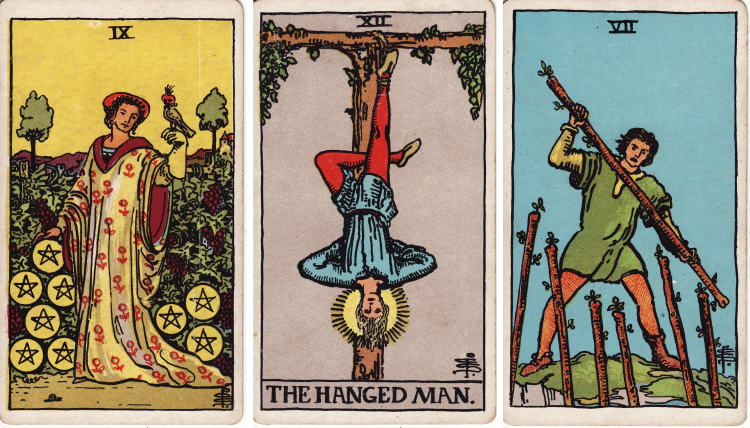Holding the Dance: A Tarot Inquiry into Being and Becoming
A psychological exploration of maintaining essential awareness while fully engaged in human experience
- Sasha Karcz
- 5 min read

Today’s tarot draw offered three cards that sparked a profound psychological inquiry: the Nine of Coins, the Hanged Man, and the Seven of Wands. Rather than seeking fortune or prediction, I approach tarot as a tool for psychological exploration—a mirror for examining the deeper currents of consciousness and the ongoing work of integration.
What emerged was an exploration of one of the deepest spiritual challenges: how to maintain essential awareness while fully participating in human experience.
The Cards as Psychological Mirrors
Nine of Coins: The figure who has achieved self-sufficiency and mastery through inner work. In Jungian terms, this represents successful individuation—identity rooted not in external roles or relationships but in Being itself.
The Hanged Man: The suspended figure seeing from an inverted perspective. This card points to the dynamic tension between transcendent awareness and mundane engagement—the challenge of living in the world without losing oneself in it.
Seven of Wands: The defender of hard-won ground. Here, the question becomes: how do we protect essential self-knowledge against the constant pull of identification with temporary roles and circumstances?
The Recognition: I AM THAT I AM
Through years of psychological and spiritual work, I’ve come to recognize that my sense of self doesn’t require anything external—not my job, my relationships, my roles, or my circumstances. While I love and appreciate these aspects of life, they are not who I am. For me, this concept is best expressed by the mystical phrase ‘I AM THAT I AM,’ which signifies an identity rooted in pure, unconditioned Being.
This realization represents what Jung called the transcendent function—identity rooted in pure Being rather than in doing, having, or relating. It’s the fruit of deep individuation work, the psychological gold that emerges from transforming the prima materia of unconscious identification.
The Challenge: Falling Asleep in the Mundane
Yet here’s the honest recognition that emerged from contemplating these cards: I often get pulled back into the mundane. The Seven of Wands fails, as it were. I drift from “I AM THAT I AM” back into “I am the frustrated husband” or “I am the person dealing with chaos” or “I am someone with unmet needs.”
This isn’t a personal failing but one of the deepest spiritual challenges—what mystics call “falling asleep” in the midst of daily life. The question isn’t how to avoid human experience but how to remain rooted in essential awareness while fully engaging with it.
The Hanged Man’s Wisdom: Holding the Opposites
The Hanged Man offers crucial insight here. That suspended figure represents not withdrawal from life but the dynamic balance point where all dualities meet. It’s not about choosing between transcendent awareness OR human engagement, but finding a way to hold both simultaneously.
This reminds me of the profound wisdom of Kashmir Shaivism, which teaches that everything is Shiva’s dance—all of existence as the dynamic play of consciousness. In this view, the world isn’t something to transcend but to recognize as the very expression of the divine. It’s both immanent and transcendent, sacred and mundane, all part of one unified movement.
Giordano Bruno held similar views—the infinite expressing itself through the finite, divinity both beyond and within everything. The mundane pull isn’t a failure but consciousness exploring itself through human experience.
Reframing the Seven of Wands
From this perspective, the Seven of Wands takes on new meaning. It’s not about defending against life or avoiding human experience. Instead, it becomes the practice of maintaining awareness that even frustration with relationships, even dealing with difficult neighbors, even sexual desires and marital struggles—all of it is consciousness playing with itself.
The defense isn’t against life but against forgetting that everything is part of the divine dance. Even the Seven of Wands “failing”—even forgetting our essential nature—becomes part of Shiva playing at forgetting and remembering himself.
The Dance of Remembering and Forgetting
Perhaps the real insight from these cards is that there’s a natural rhythm to consciousness—expansion and contraction, remembering and forgetting, being and becoming. The Seven of Wands isn’t about perfect maintenance of awareness but about the gentle return to essence when we notice we’ve drifted.
The Hanged Man shows us the suspended state where we can hold all of this lightly—neither grasping after transcendent states nor drowning in mundane identification, but recognizing the whole dance as sacred.
Living the Paradox
The cards invite an inquiry: How do we live as Shiva dancing? How do we maintain essential awareness not by withdrawing from human experience but by recognizing human experience as the very medium through which consciousness knows itself?
This is the profound challenge of integration—not transcending the world to find the divine, but recognizing the divine AS the world. Our psychological struggles, our relationship challenges, our spiritual longings—all expressions of the one consciousness exploring its own infinite nature.
Final Reflection
The Nine of Coins reminds us of what we’ve achieved through inner work—the recognition of our essential nature. The Hanged Man shows us the dynamic balance required to live this recognition fully. The Seven of Wands calls us to protect this awareness not through spiritual bypassing but through remembering that even our human struggles are sacred.
In Kashmir Shaivism, there’s a beautiful recognition that enlightenment isn’t a state to attain but our natural condition to remember. These cards point toward that remembering—not as a once-and-done achievement but as an ongoing dance of consciousness awakening to itself through every moment of human experience.
The dance continues. The awareness deepens. And even forgetting becomes part of the sacred play of remembering who we truly are.
- Tags:
- tarot
- jung
- consciousness
- imagination